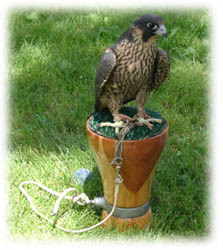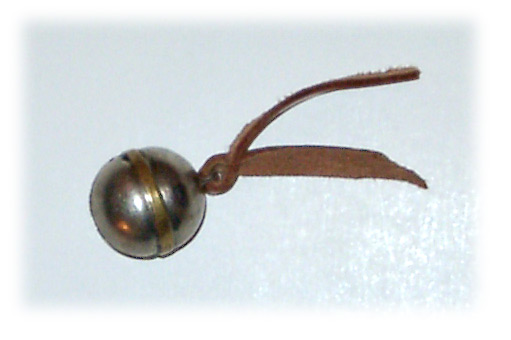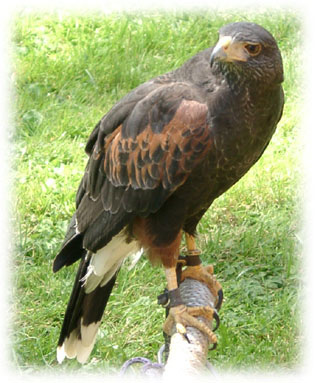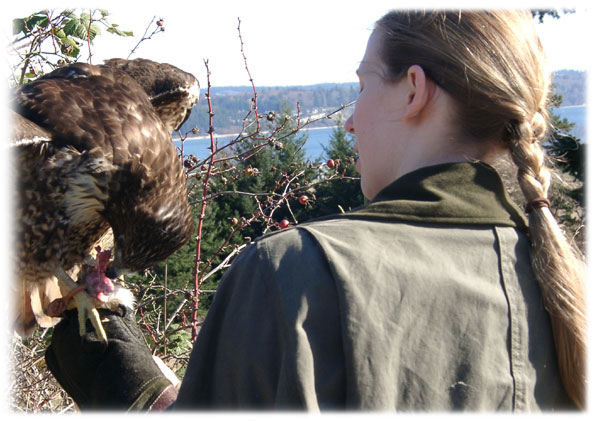
A falcon on a block perch.
We all have images of elegant ladies and gallant knights riding out for an afternoon of hunting. Fine birds are perched on their fists as the ultimate of adornments. And this image that we all hold has permeated our literature and movies. There can't be a period movie set in the Medieval age without an appearance of at least one falconer with his bird. And yet, this was not the original form of falconry - this was, instead, the height of its popularity in the west. The precise origins are, like many old things, lost in time. But there are certain facts which we can state as truths without any guess work. Through archaeological evidence we have depictions of Chinese princes receiving gifts of falcons as early as 2200 BC, however there is no evidence of hunting. Rather, the belief is that these were merely pets and prized gifts traded between heads of state. The somewhat agreed upon initial falconry artifact is an Assyrian relief from 722 BC. Closely thereafter there is positive evidence of Chinese princes engaging in falconry and evidence in Japan. The Greeks engaged in the sport and Alexander the Great was even pictured on a coin with his hawk on his fist. These were early endeavors, and in the case of the falconry in China and Japan, more for pageantry than for achieving an end result. It wasn't until the 8th or 9th century AD that we have solid evidence of falconry flourishing in the Middle East, and it is still very much alive there today. Shortly thereafter the Crusaders brought the practices from the Middle East throughout Europe where there was only rudimentary evidence of it. This lead to the falconry practices that we imagine and picture today. The falconry of the Middle East was of a different style than in Europe. Falcons were typically trapped, flown for one season, and then released again. In Europe, falcons were bought and sold and were kept for extended amounts of time. Between 500 AD and 1600 there is hardly a historical figure that can be picked out who did not spend some of his time in falconry. Kings and saints, queens and noblemen, and even the lowest of the classes engaged in falconry. The keeping of birds and hunting of them was as common then as golf is today. And it was not just practiced by the men, but by women as well. One document contains a letter from a husband to his wife instructing her to take her bird with her to church in order to have the bird tame down better. Seeing someone on the street with a bird on his wrist then was like seeing a man walking a dog today. Falconry rose quickly in popularity and remained important to the cultures throughout Europe. It was so popular that economies were based off of their falcon trade, and ransoms were demanded to include particular falconry birds. And although much of the world has changed, the practice of falconry is largely unchanged over the last thousand years. For all the cultures and all the people involved, the modifications over the centuries are relatively small. Holy Roman Emperor Frederick II of Hohenstaufen, Kublai Khan, or Empress Catherine of Russia would readily recognize the falconry practiced today as not unlike the falconry they avidly pursued.
In order to actually become a falconer, every falconer has had to find a way to get a bird. This was often accomplished by either trapping a bird or by taking a downy chick from the nest. The traps that were set up then are largely still the same ones used today and carry such exotic names as bal-chatri and dho-gazza. Most simply contained bait of a bird or mammal, and then a system of nooses to ensnare the bird's feet or a way to wrap around the bird and contain her until the trapper could gain control of the bird. Some of the materials are better, fishing line has replaced horsehair, cable ties are used where leather might have been, but the functions are identical.
The equipment of falconry is relatively minimal when compared to many other sports. A simple perch for the bird and a mechanism to attach the bird to the perch are two necessities. The same perch designs have been in use for centuries. The two basic designs are bow perches for hawks and block perches for falcons. The bow perch originated from simple branches bent over to create a bow shape, or even the hunter's bow stuck into the ground. The block perch is a stylized platform for the falcons to stand on. These are still made out of carved and turned wood, but may be made of plastics for an inexpensive and long-lasting piece.

The leash, anklets, and jesses remained identical to the original
designs until the early 1900s when Englishman Guy Aylmeri designed
a superior arrangement. These went from a strap of leather serving
as the combined anklet and jess to a two piece system allowing
the falconer to change the length and style as necessary. Small
modifications have gone into the leash as it has evolved from
a strap of leather to a strap with a button or a slit, to using
modern materials such as nylon. But the form and function remains
the same. Leather and other traditional materials wear much faster,
stretches, or become brittle over time. The strength and durability
of the synthetic materials makes them more trustworthy and safer
for the bird, but they retain the same designs that their more
traditional counterparts were.
The hood and gauntlet are almost the icons of falconry. The hood is an Arab contribution spread through Europe by the Crusaders. Each culture and each artisan has made his own modifications, but the designs used today are almost identical to those used a thousand years ago. The gauntlet is a thick glove covering the hand allowing the bird to be carried on the falconer's fist without her sharp talons digging into his own skin. Arab cultures used a similar device called a mangalah, which is a cuff covering part of the arm. The desert heat and the use of falcons instead of hawks allow for the short mangalah to be the preferred hand covering in this region.

While out hunting, these birds can almost instantly disappear
into a tree or down in the brush. Traditional falconry uses bronze
or silver bells on the bird to help locate her. The sound of the
bells makes a falconer's heart quicken as he knows his bird is
nearby.

Of the most recent changes, there are three which stand out, and
all of which are modifications of the traditional practice, not
replacements. The bells are still almost universally used by falconers;
however they are now supplemented by a tiny radio transmitter.
This can help the falconer locate a bird several miles away. With
the discovery of the New World we now have more species of birds
available to use. Birds such as the Red-Tail are not traditional
falconry birds, but the Harris' Hawk is the most recent, and most
successful, addition.

This bird is highly social and naturally works well with a
group. This trait helps her work with her falconer and team of
dogs. It has only been in the last 30 years that this bird has
joined the ranks of falconry birds.
Within that time falconers have also discovered how to captively
breed the birds they want to fly. Ancient falconry required that
a falconer trapped his own bird as there were no captively bred
birds available. This has had the additional benefit of allowing
falconers to lead repopulation efforts of endangered species such
as the Peregrine Falcon. Now that falconers have discovered how
to captively breed and artificially inseminate, they also have
the ability to selectively breed and hybridize birds. This allows
falconers to add together the desirable traits of two different
species, and to moderate some of the problems found in either
one.
Some of the largest changes for modern falconers is not how
they practice, but the restraints under which they do. The distinct
lack of huntable grounds available to them has changed falconry
considerably. Some countries that were pivotal to falconry in
the past no longer recognize falconry as a means to take game.
Although almost all of the states in the US recognize falconry
as a hunting sport, the land on which it may be practiced is rapidly
shrinking. Modern falconers work hard to develop relationships
with land owners and to discover new land that will be suitable
for flying their bird.
The largest impact to modern falconers is the modern legalities
under which falconers practice their sport. A modern falconer
in America has to work closely with his state Department of Fish
and Wildlife as well as federal authorities. He must apply for
permits and licenses, pass an extensive test of his knowledge,
build a housing structure for his bird, have his facilities inspected,
and acquire all required equipment before he ever possesses his
own bird. For the first two years he is then apprenticed to an
experienced falconer who will guide and teach him how to care
for and train this bird. Only after a minimum of two years as
an apprentice will he be allowed to practice falconry on his own
and with almost any species of raptor he chooses. It is a long
process and he is judged during every stage.
Even though falconry, by definition, requires the falconer to
be hunting with their bird, falconry is not the blood sport that
some perceive. There are more effective means of catching game
with far less effort. The success rate does not match hunting
with a gun, and a bird needs constant, daily attention that a
bow or snare do not need. Instead, it is the ultimate bird watching
experience. The falconry birds do not need to be trained to hunt,
for they do that in the wild. They are instead trained to allow
us to be a part of their hunt - to allow us as a partner. It is
the ultimate partnership to have a wild animal accept you and
even look forward to you for help and assistance in their natural
activities.

We hope the information on the PrimitiveWays website is both instructional and enjoyable. Understand that no warranty or guarantee is included. We expect adults to act responsibly and children to be supervised by a responsible adult. If you use the information on this site to create your own projects or if you try techniques described on PrimitiveWays, behave in accordance with applicable laws, and think about the sustainability of natural resources. Using tools or techniques described on PrimitiveWays can be dangerous with exposure to heavy, sharp or pointed objects, fire, stone tools and hazards present in outdoor settings. Without proper care and caution, or if done incorrectly, there is a risk of property damage, personal injury or even death. So, be advised: Anyone using any information provided on the PrimitiveWays website assumes responsibility for using proper care and caution to protect property, the life, health and safety of himself or herself and all others. He or she expressly assumes all risk of harm or damage to all persons or property proximately caused by the use of this information.
© PrimitiveWays 2016